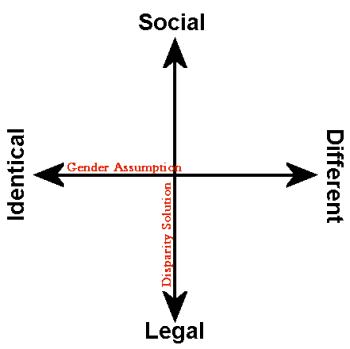« Who would you invite to Christmas dinner? | Main | Saturday reading -- so much, too little time »
December 15, 2005
On Feminism: a quadrant answer to a binary question
The discussion and debate over "authentic" Feminism continues with especially noteworthy posts from Jeff Goldstein and Cathy Young. Certainly the volume of recent writing and the long comments threads have yielded much heat (and some light), even if the "sides" in the debate still have yet to agree on terms.
Lauren at Feministe observes:
I still find the binary problematic because it is so very reductive. Young and Hoff-Summers’ definitions of “gender feminism” don’t describe me at all, but I find little in the “equity feminist” camp that applies to me outside of the most basic philosophy.While I partially agree with Lauren that there are arguments within Feminism on specific issues that demonstrate no monolithic dogma, I believe there are some significant differences that do divide American Feminist ideology along some very clear lines.
If we assume the initial, observable premise that gender disparities exist, we can then plot the very different assumptions and solutions that divide American Feminism into very different camps.
I'm specifically dealing with American Feminism because, Constitutionally, we are already equal before the law as citizens - i.e. American women already have the vote and are not legally barred from any profession or elected office that similarly qualified men have the opportunity to pursue.
With that in mind, I would set up my initial graph thusly:
X axis - Gender Assumption
At one end "Indentical": men and women are the same, interchangeable. Any gender difference is the sole result of societal/familial pressures to conform to rigid, defined sex roles.
At the other end "Different": men and women are inherently different. Regardless of the whims of societal/familial pressures, certain behaviors will remain constant.
Y axis - Disparity Solution
At the top "Social" - the best way to deal with observable gender differences is through persuasion, i.e. debate, discussion, or private action.
At the bottom "Legal" - the best way to deal with observable gender differences is through law and/or the courts.
Thus we have four quadrants that will cover the significant breaks in American Feminism.

What I'm going to do next is to develop sets of questions specific to this graph and create a simple program that will allow someone to chart where they will fall within the quadrants.
Discussion and suggestions for relevant questions or even the naming of the quadrants welcome.
Posted by Darleen at December 15, 2005 12:16 PM
Comments
What a great idea!
Posted by: Robert at December 16, 2005 04:46 PM
This is interesting. Same basic idea as the World's Smallest Political Quiz. Hope you finish it soon!
Posted by: Marian at December 16, 2005 09:09 PM